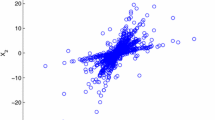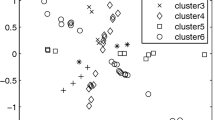Abstract
Underdetermined blind source separation (UBSS) is an important issue for sparse signals, and a novel two-step approach for UBSS based on the law of large numbers and minimum intersection angle rule (LM method) is presented. In the first step, an estimation of the mixed matrix is obtained by using the law of large numbers, and the number of source signals is displayed graphically. In the second step, a method of estimating the source signals by the minimum intersection angle rule is proposed. The significance of this step is that the minimum intersection rule is better than the shortest path method, and the decomposition components can be found optimally by the former. The simulation results illustrate the effectiveness of the LM method. It has a simple principle, has good transplantation capability and may be widely applied in various fields of digital signal processing.














Similar content being viewed by others
References
P. Bofill, M. Zibulevsky, Underdetermined source separation using sparse representation. Signal Process. 81(11), 2353–2362 (2001)
C. Deng, Y. Wei, Y. Shen, Q. Su, J. Xu, An improved approach of blind source separation for delayed sources using Taylor series expansion, in 3rd IEEE International Conference on Computer and Communications (2017), pp. 284–288
W. Fu, B. Nong, X. Zhou, J. Liu, C. Li, Source recovery in underdetermined blind source separation based on artificial neural network. China Commun. 15(1), 140–154 (2018)
Y. Jia, P. Xu, Underdetermined blind source separation applied to the ultra-wideband communication signals. J. Nanjing Univ. Posts Telecommun. 31(1), 23–28 (2011)
S. Kim, C.D. Yoo, Underdetermined blind source separation based on subspace representation. IEEE Trans. Signal Process. 57(7), 2604–2614 (2009)
Y. Li, S. Amari, A. Cichocki, D.W.C. Ho, S. Xie, Underdetermined blind source separation based on sparse representation. IEEE Trans. Signal Process. 54(2), 423–437 (2006)
B. Liu, V.G. Reju, A.W.H. Khong, A linear source recovery method for underdetermined mixtures of uncorrelated AR-model signals without sparseness. IEEE Trans. Signal Process. 62(19), 4947–4958 (2014)
S. Mirzaei, H. Van, Y. Norouzi, Blind audio source counting and separation of anechoic mixtures using the multichannel complex NMF framework. Signal Process. 115, 27–37 (2015)
R. Peled, S. Braun, M. Zacksenhouse, A blind deconvolution separation of multiple sources, with application to bearing diagnostics. Mech. Syst. Signal Process. 19(6), 1181–1195 (2005)
L. Stanković, E. Sejdić, S. Stanković, M. Daković, I. Orović, A tutorial on sparse signal reconstruction and its applications in signal processing. Circuits Syst. Signal Process. 38(3), 1206–1263 (2019)
O. Tichý, V. Šmídl, Bayesian blind separation and deconvolution of dynamic image sequences using sparsity priors. IEEE Trans. Med. Imaging 34(1), 258–266 (2015)
S. Van Vaerenbergh, I. Santamaria, Spectral clustering approach to underdetermined postnonlinear blind source separation of sparse sources. IEEE Trans. Neural Netw. 17(3), 811–814 (2006)
S. Xie, L. Yang, J. Yang, G. Zhou, Y. Xiang, Time–frequency approach to underdetermined blind source separation. IEEE Trans. Neural Netw. Learn. Syst. 23(2), 306–316 (2012)
L. Zhen, D. Peng, Z. Yi, Y. Xiang, P. Chen, Underdetermined blind source separation using sparse coding. IEEE Trans. Neural Netw. Learn. Syst. 28(12), 3102–3108 (2017)
Y. Zhang, S. Zhang, R. Qi, Compressed sensing construction for underdetermined source separation. Circuits Syst. Signal Process. 36(11), 4741–4755 (2017)
Acknowledgements
The authors would like to thank the anonymous reviewers for their insightful comments and helpful critiques of the manuscript that helped improve this paper. This work was partially supported by the Natural Science Foundation of Jiangsu Province (No. BK20171267) and the Major Program of the Natural Science Research of Jiangsu Higher Education Institutions of China (No. 18KJA520002).
Author information
Authors and Affiliations
Corresponding author
Additional information
Publisher's Note
Springer Nature remains neutral with regard to jurisdictional claims in published maps and institutional affiliations.
Rights and permissions
About this article
Cite this article
Xu, P., Jia, Y., Wang, Z. et al. Underdetermined Blind Source Separation for Sparse Signals Based on the Law of Large Numbers and Minimum Intersection Angle Rule. Circuits Syst Signal Process 39, 2442–2458 (2020). https://doi.org/10.1007/s00034-019-01263-2
Received:
Revised:
Accepted:
Published:
Issue Date:
DOI: https://doi.org/10.1007/s00034-019-01263-2




